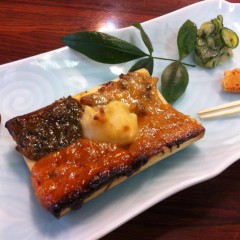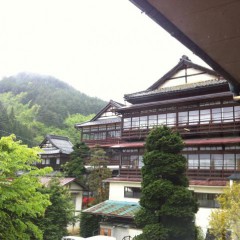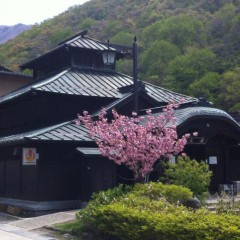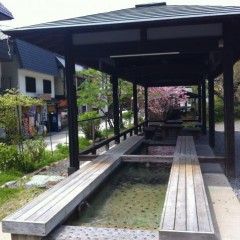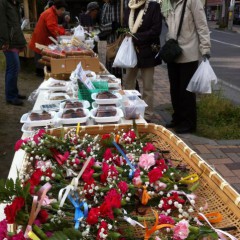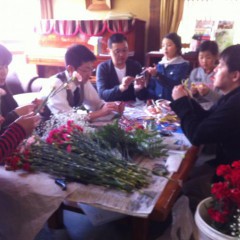
Manzansou's outdoor bath at Oku-Yamada Onsen
長野温泉トップ100の本の作成の手伝いで作家のPeterさんと信州高山村の松川渓谷温泉郷に行ってみました。前回は山田温泉の話でした。今回はその奥(距離は更に8.3km、標高は更に600m)の奥山田温泉。
奥山田温泉は標高1500mの高台にある。宿泊施設十数件で、お湯は濁り系で強い硫黄泉です。山田温泉から車で約15分です。(車の無い方は山田温泉までバスで、後はタクシーになってしまいます。しかし、山田温泉に普段はタクシーがないために事前に手配する必要がある。自転車で登る方もいらっしゃるようですが、初心者には無理でしょう。)
山田温泉は松川渓谷の谷間の景色ですが、そこからくねくねの道で上って上って、やっと奥山田高台にたどり着きます。冬はスキー場(グレンデの2割ぐらいしかグルーミングされていない;自然な雪で滑りたい方に喜ばれているようです);夏は牧場。西は長野市への眺め、北東に笠ヶ岳(超えたら志賀高原)、南北は万座山(トレッキングの二日間一泊の最適なループコース)。
恐らく一番有名な宿は満山荘。日本秘湯を守る会のメンバー。奥山田温泉全体は「秘湯」な雰囲気:あまり知られていないし、場所は山奥のとんでもない所。その中の1軒はこの芸術的な手作り感のある満山荘。露天風呂から遠くの長野市盆地まで見れる。
そして、恐らく一番ユニークなお風呂はレッドウッド・インです。樹齢1650年の直径3.2mのあるレッドウッドの丸太がくり抜いた部分が浴槽となっている。噂は前から聞いていたけど、自分の目で見れて、感動しました。男湯から笠ヶ岳も見れて、良い雰囲気。
And the Nagano Onsen Top 100 project goes on. I am helping my buddy Peter write a book about Nagano Onsens, and we took another trip, first to Yamada Onsen (see the previous entry) and then to Oku-Yamada Onsen.
"Oku" means "further back". I had thought Yamada Onsen, situated like it is in the midst of the Matsukawa Gorge, was about as deep into the mountains as you could go. Little did I know that deeper and up into the mountains is this flat spot at 1500m altitude, that to the west, overlooks Nagano City and the Zenkoji Plain in the distance, and to the east, is towered over by Mt. Kasa-ga-dake and Mt. Manza.
In the winter, this spot becomes the Yamaboko ski area (with 70% of the runs left un-groomed for a wild, natural snow experience). And in the summer, it becomes Yamada Bokujo Ranch, with cows wandering around grazing. It's a destination for bicyclists who like lots of altitude gain, and a starting point for trekkers (apparently the 'Oku-Yamada - over Kasa-ga-dake to Shiga Kogen, cross over to Manza Onsen, then over Mt. Manza and back down to Oku-Yamada' course is the perfect 2-day loop trek.)
Oku-Yamada is 8.3km past and up from Yamada Onsen, about 15 minutes by car. If you came by bus to Yamada Onsen, the best way is to pre-arrange for a taxi to meet you there to take you the rest of the way to Oku-Yamada.
The onsen water here is of the milky-variety with a strong sulfur content. It definitely makes for a memorable onsen experience.
Perhaps the best known inn here is Manzansou. Although Manzansou itself is a member of the Japan Association of Secluded Hot Spring Inns, if you ask me, all of Oku-Yamada could qualify. Not many people know of Oku-Yamada, and its location deep and up into the mountains is certainly secluded. Anyways, Manzansou has artistic, hand-made touches throughout, giving it a special, one-of-a-kind feel. And the outdoor baths, with their views of Nagano City below in the distance, are unforgettable.
The inn with the most novel onsen bath is the Redwood Inn. Their outdoor baths are made out of hallowed-out slices cut from a 1650-year old real redwood tree. I had heard rumors of the redwood baths but it was impressive to see them in person. And the mens bath was particularly nice with the view of Mt. Kasa-ga-dake looming the background
満山荘 Manzansou
レッドウッド・イン Redwood Inn

Artistic approach to the secluded Manzansou
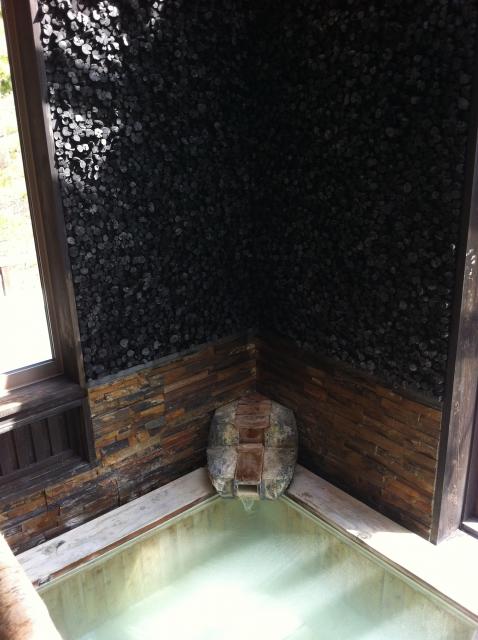
Unique touches to Manzansou's indoor bath

The legendary redwood onsen bath




